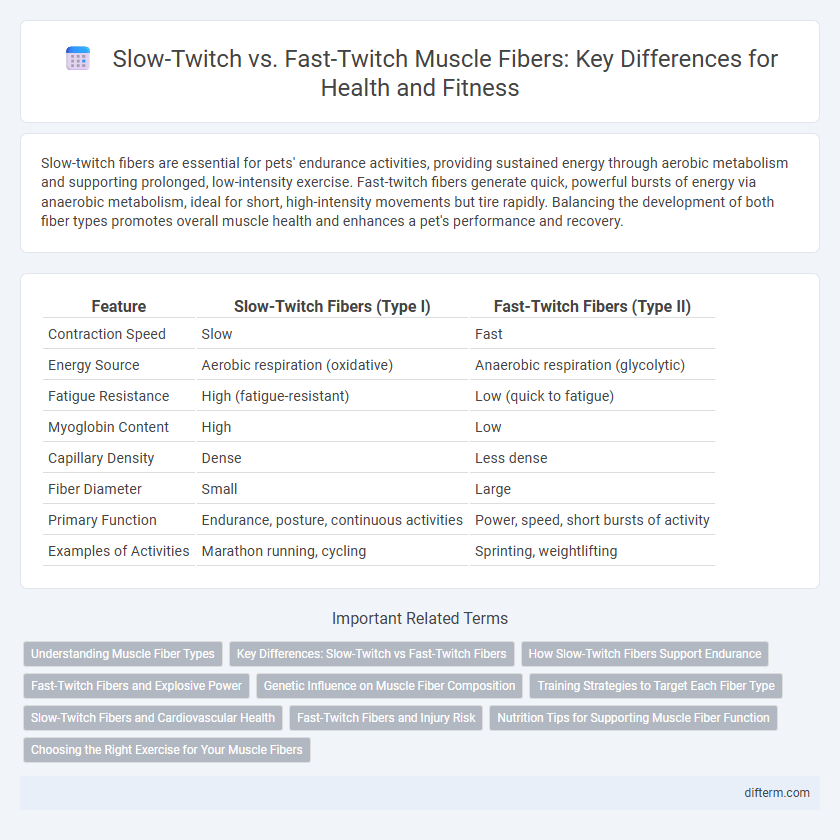Slow-twitch fibers are essential for pets' endurance activities, providing sustained energy through aerobic metabolism and supporting prolonged, low-intensity exercise. Fast-twitch fibers generate quick, powerful bursts of energy via anaerobic metabolism, ideal for short, high-intensity movements but tire rapidly. Balancing the development of both fiber types promotes overall muscle health and enhances a pet's performance and recovery.
Table of Comparison
| Feature | Slow-Twitch Fibers (Type I) | Fast-Twitch Fibers (Type II) |
|---|---|---|
| Contraction Speed | Slow | Fast |
| Energy Source | Aerobic respiration (oxidative) | Anaerobic respiration (glycolytic) |
| Fatigue Resistance | High (fatigue-resistant) | Low (quick to fatigue) |
| Myoglobin Content | High | Low |
| Capillary Density | Dense | Less dense |
| Fiber Diameter | Small | Large |
| Primary Function | Endurance, posture, continuous activities | Power, speed, short bursts of activity |
| Examples of Activities | Marathon running, cycling | Sprinting, weightlifting |
Understanding Muscle Fiber Types
Slow-twitch fibers, also known as Type I fibers, are endurance-oriented muscle fibers characterized by high mitochondrial density and rich capillary networks, enabling sustained aerobic activity and efficient fatigue resistance. Fast-twitch fibers, or Type II fibers, generate quick, powerful contractions through anaerobic metabolism but fatigue rapidly due to lower mitochondrial content and limited oxygen supply. Understanding the differences between these muscle fiber types is crucial for optimizing training protocols, injury prevention, and enhancing athletic performance.
Key Differences: Slow-Twitch vs Fast-Twitch Fibers
Slow-twitch fibers, also known as Type I fibers, are characterized by high mitochondrial density and rely on aerobic metabolism, making them ideal for endurance activities and sustained muscle contractions. Fast-twitch fibers, or Type II fibers, generate rapid and powerful contractions through anaerobic metabolism but fatigue quickly due to lower mitochondrial content. The key differences between these fiber types influence athletic performance, muscle fatigue resistance, and training adaptations.
How Slow-Twitch Fibers Support Endurance
Slow-twitch fibers, also known as Type I muscle fibers, contain a high density of mitochondria and rich capillary networks that enhance oxygen delivery and energy production through aerobic metabolism. These fibers sustain prolonged muscle contractions by efficiently using fat as an energy source, thereby reducing muscle fatigue during endurance activities such as long-distance running and cycling. Their resistance to fatigue and ability to generate ATP over extended periods make slow-twitch fibers essential for maintaining stamina and endurance performance.
Fast-Twitch Fibers and Explosive Power
Fast-twitch fibers generate rapid, forceful contractions ideal for explosive power activities such as sprinting and weightlifting. These fibers fatigue quickly but produce high-intensity output by utilizing anaerobic metabolism. Training fast-twitch fibers enhances muscle strength, speed, and power essential for athletic performance and short-duration, high-intensity movements.
Genetic Influence on Muscle Fiber Composition
Genetic factors play a crucial role in determining the proportion of slow-twitch and fast-twitch muscle fibers an individual possesses, influencing their natural aptitude for endurance or power activities. Studies show that genetics account for approximately 45-99% of the variability in muscle fiber composition, with specific gene variants such as ACTN3 linked to fast-twitch fiber prevalence. Understanding these genetic influences aids in personalized training regimens and optimizing athletic performance based on one's muscle fiber makeup.
Training Strategies to Target Each Fiber Type
Training strategies for slow-twitch fibers emphasize endurance workouts involving prolonged, low-intensity activities like long-distance running or cycling to enhance aerobic capacity and muscular endurance. Fast-twitch fibers respond best to high-intensity, short-duration exercises such as sprinting, weightlifting, or plyometrics that promote power, speed, and muscle hypertrophy. Incorporating a periodized training plan alternating between aerobic endurance and anaerobic power sessions optimizes recruitment and adaptation of both fiber types for balanced muscular development.
Slow-Twitch Fibers and Cardiovascular Health
Slow-twitch fibers, also known as Type I muscle fibers, are highly efficient in utilizing oxygen to generate sustained energy, making them essential for cardiovascular endurance and overall heart health. These fibers support prolonged aerobic activities like running or cycling, which improve blood circulation, reduce blood pressure, and enhance the efficiency of the cardiovascular system. Regular training that targets slow-twitch fibers promotes increased mitochondrial density and capillary networks, crucial for maintaining a healthy heart and preventing cardiovascular disease.
Fast-Twitch Fibers and Injury Risk
Fast-twitch fibers generate rapid, powerful contractions ideal for explosive movements but have a higher susceptibility to injury due to their lower endurance and quicker fatigue onset. These fibers are more prone to strains and tears during intense or unaccustomed high-intensity activities because of their rapid force production capabilities. Proper conditioning and gradual load progression are essential to mitigate injury risks associated with fast-twitch muscle fiber dominance.
Nutrition Tips for Supporting Muscle Fiber Function
Optimal nutrition for supporting slow-twitch fibers emphasizes complex carbohydrates and omega-3 fatty acids to enhance endurance and mitochondrial efficiency. Fast-twitch fibers benefit from higher protein intake and creatine supplementation to support rapid energy production and muscle repair. Balanced hydration and antioxidant-rich foods reduce oxidative stress, promoting overall muscle fiber function and recovery.
Choosing the Right Exercise for Your Muscle Fibers
Slow-twitch fibers excel in endurance activities due to their high mitochondrial density and efficient oxygen use, making exercises like long-distance running or cycling ideal. Fast-twitch fibers generate greater force and power but fatigue rapidly, benefitting from short bursts of high-intensity training such as sprinting or weightlifting. Tailoring workouts to target your dominant muscle fiber type can optimize performance and muscle adaptation.
slow-twitch fibers vs fast-twitch fibers Infographic

 difterm.com
difterm.com